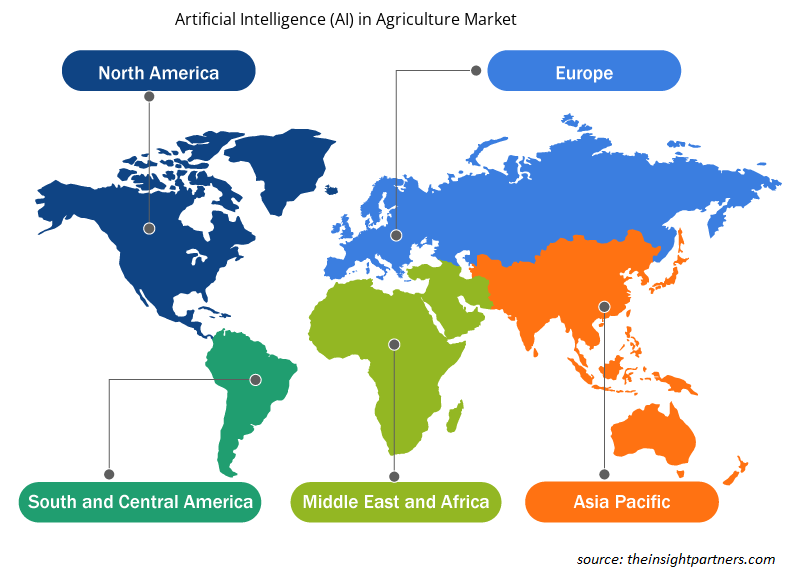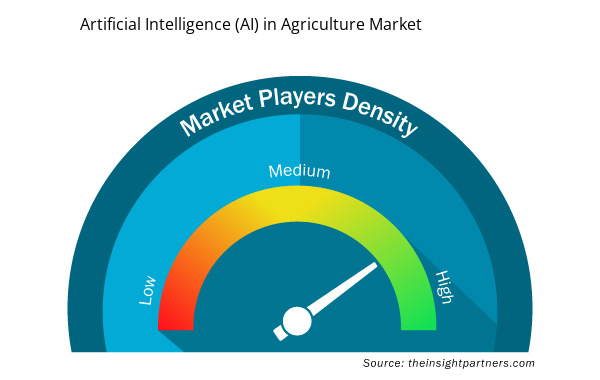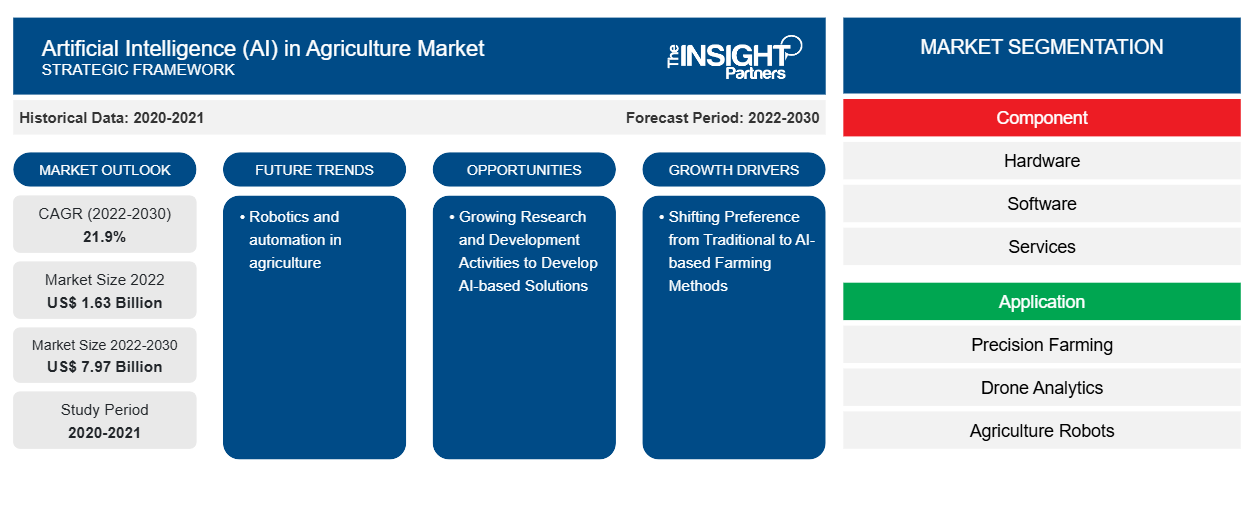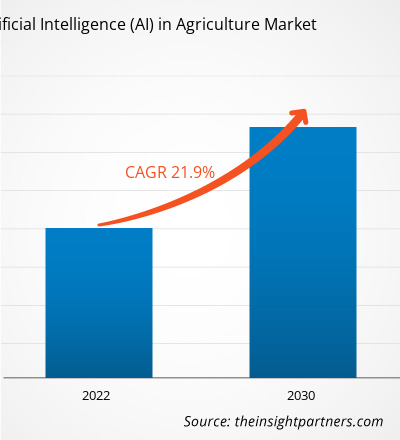تم تقييم حجم سوق الذكاء الاصطناعي في الزراعة بنحو 1.63 مليار دولار أمريكي في عام 2022 ومن المتوقع أن يصل إلى 7.97 مليار دولار أمريكي بحلول عام 2030؛ ومن المتوقع أن يسجل معدل نمو سنوي مركب بنسبة 21.9٪ من عام 2022 إلى عام 2030. ومن المرجح أن تظل الروبوتات والأتمتة في الزراعة من الاتجاهات الرئيسية في السوق.
تحليل سوق الذكاء الاصطناعي في الزراعة
إن التحول من التفضيلات التقليدية إلى أساليب الزراعة القائمة على الذكاء الاصطناعي، والاستخدام المتزايد للطائرات بدون طيار في الزراعة، والحاجة المتزايدة إلى التحليلات في الوقت الفعلي في الزراعة هي عوامل تدفع السوق. ومن المتوقع أن ينمو السوق خلال فترة التوقعات، بسبب الدعم الحكومي المتزايد لتنفيذ حلول الذكاء الاصطناعي. وعلاوة على ذلك، فإن أنشطة البحث والتطوير المتزايدة لتطوير حلول تعتمد على الذكاء الاصطناعي وزيادة الزراعة الذكية تخلق فرصًا مربحة للسوق.
نظرة عامة على سوق الذكاء الاصطناعي في الزراعة
يحدث الذكاء الاصطناعي ثورة في صناعة الزراعة. تساعد التحليلات التنبؤية والرؤية الحاسوبية والتعلم الآلي وتحليلات البيانات الزراعة على التغلب على العقبات وتحقيق إمكاناتها الكاملة. يسمح استخدام الذكاء الاصطناعي في الزراعة بجمع البيانات وتحليلها من مجموعة متنوعة من المصادر، بما في ذلك ظروف التربة وأنماط الطقس وصحة المحاصيل والبيانات التاريخية.
يمكن للأنظمة القائمة على الذكاء الاصطناعي أن تزود المزارعين بمعلومات قيمة لزيادة الغلة، والحد من النفايات، وتقليل المخاوف البيئية. ويمكن للمزارعين وأصحاب المصلحة استخدام الرؤى القائمة على البيانات واتخاذ القرارات الذكية لتعزيز الإنتاجية، وتحسين استخدام الموارد، والتعامل مع القضايا الزراعية. ويمكن استخدام الآلات الذكية والروبوتات لأتمتة المهام الرتيبة في الزراعة. وتساعد هذه التطورات المزارع على معالجة نقص القوى العاملة والتركيز على التخطيط والإدارة الاستراتيجية.
قم بتخصيص هذا التقرير ليناسب متطلباتك
ستحصل على تخصيص لأي تقرير - مجانًا - بما في ذلك أجزاء من هذا التقرير، أو تحليل على مستوى الدولة، وحزمة بيانات Excel، بالإضافة إلى الاستفادة من العروض والخصومات الرائعة للشركات الناشئة والجامعات
- احصل على أهم اتجاهات السوق الرئيسية لهذا التقرير.ستتضمن هذه العينة المجانية تحليلاً للبيانات، بدءًا من اتجاهات السوق وحتى التقديرات والتوقعات.
الذكاء الاصطناعي في الزراعة: العوامل المحركة والفرص المتاحة
التحول من التفضيلات التقليدية إلى أساليب الزراعة القائمة على الذكاء الاصطناعي
واجه مزارعو البطاطس التقليديون في جميع أنحاء كندا تحديات في إدارة المغذيات، وهو جانب حاسم من الزراعة يؤثر بشكل مباشر على غلة المحاصيل. إن الطرق التقليدية لمعالجة التربة والتغذية الورقية، على الرغم من فعاليتها إلى حد ما، لها قيود، خاصة فيما يتعلق بالمغذيات المطلوبة في المراحل اللاحقة من نمو البطاطس. وبالتالي، ينشر مزارعو البطاطس في جميع أنحاء كندا حلول الذكاء الاصطناعي للتنبؤ بالاحتياجات الغذائية لنبات البطاطس. على سبيل المثال، في نوفمبر 2023، مع التطورات الرائدة في القطاع الزراعي، يتجه مزارعو البطاطس الكنديون إلى الذكاء الاصطناعي لمراقبة وتوقع الاحتياجات الغذائية لمحاصيلهم في الوقت الفعلي. وبالتالي، فإن اعتماد المزارعين الكنديين للذكاء الاصطناعي يدفع نمو الذكاء الاصطناعي في سوق الزراعة.
تزايد أنشطة البحث والتطوير لتطوير حلول تعتمد على الذكاء الاصطناعي
تتميز المملكة المتحدة بقدرات بحثية وتكنولوجية عالمية المستوى وهي الرائدة عالميًا في تطوير الحلول التي تعتمد على الذكاء الاصطناعي. علاوة على ذلك، يستخدم الباحثون في المملكة المتحدة الذكاء الاصطناعي لإحداث ثورة في الصناعات التقليدية مثل الزراعة. وفقًا لبيانات يناير 2024، يحاول الباحثون في جامعة هاربر آدامز جعل الزراعة أكثر استدامة وإنتاجية باستخدام الذكاء الاصطناعي.
كما أعلنت حكومة المملكة المتحدة عن تمويل بقيمة 39.82 مليون دولار أمريكي لدعم تطوير مشاريع الذكاء الاصطناعي في قطاعات متنوعة مثل الزراعة والأزياء وخدمات الطوارئ. كما تم منح 5.38 مليون دولار أمريكي إضافية لدراسات الجدوى لـ 100 مشروع من الشركات الصغيرة، وتعزيز أفكار الذكاء الاصطناعي المبتكرة لتعزيز الإنتاجية في مختلف القطاعات. وبالتالي، من المتوقع أن يعمل هذا الدعم الحكومي على دفع نمو الذكاء الاصطناعي في سوق الزراعة.
تقرير تحليل تجزئة سوق الذكاء الاصطناعي في الزراعة
إن القطاعات الرئيسية التي ساهمت في استخلاص تحليل سوق الذكاء الاصطناعي في الزراعة هي المكونات والتطبيقات.
- بناءً على المكون، ينقسم سوق الذكاء الاصطناعي في الزراعة إلى أجهزة وبرامج وخدمات. احتل قطاع الأجهزة حصة سوقية أكبر في عام 2022.
- من حيث التطبيق، ينقسم السوق إلى الزراعة الدقيقة ، وتحليلات الطائرات بدون طيار، والروبوتات الزراعية، ومراقبة الماشية، وغيرها. احتل قطاع الزراعة الدقيقة حصة سوقية أكبر في عام 2022.
تحليل حصة سوق الذكاء الاصطناعي في الزراعة حسب المنطقة الجغرافية
ينقسم النطاق الجغرافي لتقرير سوق الذكاء الاصطناعي في الزراعة بشكل أساسي إلى خمس مناطق: أمريكا الشمالية، وآسيا والمحيط الهادئ، وأوروبا، والشرق الأوسط وأفريقيا، وأمريكا الجنوبية والوسطى.
من المتوقع أن يتوسع السوق في منطقة آسيا والمحيط الهادئ خلال فترة التنبؤ، بسبب الطلب المتزايد على الحلول المتقدمة تقنيًا. في دول مثل أستراليا، حيث تتقدم القوى العاملة الزراعية في السن بسرعة، فإن الطلب على العمالة الماهرة أكبر من أي وقت مضى. الزراعة، مع تكاملها مع التكنولوجيا المتطورة مثل الذكاء الاصطناعي والتعلم الآلي، تحمل المفتاح لسد هذه الفجوة وإدخال الزراعة إلى العصر المعاصر. يشهد العديد من المزارعين الأستراليين بالفعل فوائد الأنظمة التي تعمل بالذكاء الاصطناعي. على سبيل المثال، في أكتوبر 2023، نشرت شركة Sunray Strawberries في Wamuran نظام المراقبة الآلي DeepBerry؛ يستخدم النظام كل من التصوير المرئي والأشعة تحت الحمراء للكشف بدقة عن النضج والكدمات والفطريات وحجم الفاكهة وشكلها والأجسام الغريبة. يمكنه معالجة أكثر من 7000 حبة غونيت في الساعة. إن تنفيذ مثل هذه الأنظمة الآلية يدفع نمو الذكاء الاصطناعي في سوق الزراعة.
الذكاء الاصطناعي في سوق الزراعة: رؤى إقليمية
لقد قام المحللون في Insight Partners بشرح الاتجاهات والعوامل الإقليمية المؤثرة على سوق الذكاء الاصطناعي في الزراعة طوال فترة التنبؤ بشكل شامل. يناقش هذا القسم أيضًا قطاعات سوق الذكاء الاصطناعي في الزراعة والجغرافيا في جميع أنحاء أمريكا الشمالية وأوروبا ومنطقة آسيا والمحيط الهادئ والشرق الأوسط وأفريقيا وأمريكا الجنوبية والوسطى.

- احصل على البيانات الإقليمية المحددة للذكاء الاصطناعي (AI) في سوق الزراعة
نطاق تقرير سوق الذكاء الاصطناعي في الزراعة
| سمة التقرير | تفاصيل |
|---|---|
| حجم السوق في عام 2022 | 1.63 مليار دولار أمريكي |
| حجم السوق بحلول عام 2030 | 7.97 مليار دولار أمريكي |
| معدل النمو السنوي المركب العالمي (2022-2030) | 21.9% |
| البيانات التاريخية | 2020-2021 |
| فترة التنبؤ | 2022-2030 |
| القطاعات المغطاة | حسب المكون
|
| المناطق والدول المغطاة | أمريكا الشمالية
|
| قادة السوق وملفات تعريف الشركات الرئيسية |
|
كثافة اللاعبين في سوق الذكاء الاصطناعي في الزراعة: فهم تأثيره على ديناميكيات الأعمال
يشهد سوق الذكاء الاصطناعي في الزراعة نموًا سريعًا، مدفوعًا بالطلب المتزايد من المستخدم النهائي بسبب عوامل مثل تفضيلات المستهلكين المتطورة والتقدم التكنولوجي والوعي الأكبر بفوائد المنتج. ومع ارتفاع الطلب، تعمل الشركات على توسيع عروضها والابتكار لتلبية احتياجات المستهلكين والاستفادة من الاتجاهات الناشئة، مما يعزز نمو السوق.
تشير كثافة اللاعبين في السوق إلى توزيع الشركات أو المؤسسات العاملة في سوق أو صناعة معينة. وهي تشير إلى عدد المنافسين (اللاعبين في السوق) الموجودين في مساحة سوق معينة نسبة إلى حجمها أو قيمتها السوقية الإجمالية.
الشركات الكبرى العاملة في سوق الذكاء الاصطناعي في الزراعة هي:
- شركة تول للتكنولوجيا
- شركة بريسيجن هوك
- إيزي تو سي أغ تيك إس إل
- ديري وشركاه
- شركة المناخ المحدودة
- جامايا إس إيه
إخلاء المسؤولية : الشركات المذكورة أعلاه ليست مرتبة بأي ترتيب معين.

- احصل على نظرة عامة على أهم اللاعبين الرئيسيين في سوق الذكاء الاصطناعي في الزراعة
الذكاء الاصطناعي في سوق الزراعة – أخبار وتطورات حديثة
يتم تقييم سوق الذكاء الاصطناعي في الزراعة من خلال جمع البيانات النوعية والكمية بعد البحث الأولي والثانوي، والتي تتضمن منشورات الشركات المهمة وبيانات الجمعيات وقواعد البيانات. فيما يلي بعض التطورات في سوق الذكاء الاصطناعي في الزراعة:
- أعلنت شركة Chipotle Mexican Grill عن استثمارات أقلية في شركتي Greenfield Robotics وNitricity. سيساعد الاستثمار من Chipotle شركة Greenfield Robotics على توسيع أسطولها وتطوير قدرات إضافية لروبوتاتها، مثل الرش الدقيق وزراعة المحاصيل الغطائية واختبار التربة. (المصدر: Chipotle Mexican Grill، موقع الشركة على الويب، ديسمبر 2023).
تغطية تقرير سوق الذكاء الاصطناعي في الزراعة والنتائج المتوقعة
يقدم تقرير "حجم سوق الذكاء الاصطناعي (AI) في الزراعة وتوقعاته (2020-2030)" تحليلاً مفصلاً للسوق يغطي المجالات التالية:
- حجم سوق الذكاء الاصطناعي في الزراعة وتوقعاته على المستويات العالمية والإقليمية والوطنية لجميع قطاعات السوق الرئيسية التي يغطيها النطاق
- اتجاهات سوق الذكاء الاصطناعي في الزراعة بالإضافة إلى ديناميكيات السوق مثل المحركات والقيود والفرص الرئيسية
- تحليل مفصل لقوى PEST/Porter الخمس وSWOT
- تحليل سوق الذكاء الاصطناعي في الزراعة يغطي اتجاهات السوق الرئيسية والإطار العالمي والإقليمي واللاعبين الرئيسيين واللوائح والتطورات الأخيرة في السوق
- تحليل المشهد الصناعي والمنافسة الذي يغطي تركيز السوق، وتحليل خريطة الحرارة، واللاعبين البارزين، والتطورات الأخيرة في سوق الذكاء الاصطناعي في الزراعة
- ملفات تعريف الشركة التفصيلية
- التحليل التاريخي (سنتان)، السنة الأساسية، التوقعات (7 سنوات) مع معدل النمو السنوي المركب
- تحليل PEST و SWOT
- حجم السوق والقيمة / الحجم - عالميًا وإقليميًا وقطريًا
- الصناعة والمنافسة
- مجموعة بيانات Excel



Report Coverage
Revenue forecast, Company Analysis, Industry landscape, Growth factors, and Trends

Segment Covered
This text is related
to segments covered.

Regional Scope
North America, Europe, Asia Pacific, Middle East & Africa, South & Central America

Country Scope
This text is related
to country scope.
الأسئلة الشائعة
Shifting preference from traditional to AI-based farming methods is the major factors that propel the global artificial intelligence (AI) in agriculture market.
North America dominated the artificial intelligence (AI) in agriculture market in 2023.
The global artificial intelligence (AI) in agriculture market is estimated to register a CAGR of 21.9% during the forecast period 2023–2031.
The global artificial intelligence (AI) in agriculture market is expected to reach US$ 9.48 billion by 2031.
Robotics and automation in agriculture to play a significant role in the global artificial intelligence (AI) in agriculture market in the coming years.
The key players holding majority shares in the global artificial intelligence (AI) in agriculture market are Tule Technologies Inc, PrecisionHawk Inc, Easytosee Agtech SL, Deere & Co, Climate LLC, Gamaya SA, International Business Machines Corp, Microsoft Corp, Prospera Technologies Ltd, and Taranis.
Trends and growth analysis reports related to Technology, Media and Telecommunications : READ MORE..
The Insight Partners performs research in 4 major stages: Data Collection & Secondary Research, Primary Research, Data Analysis and Data Triangulation & Final Review.
- Data Collection and Secondary Research:
As a market research and consulting firm operating from a decade, we have published and advised several client across the globe. First step for any study will start with an assessment of currently available data and insights from existing reports. Further, historical and current market information is collected from Investor Presentations, Annual Reports, SEC Filings, etc., and other information related to company’s performance and market positioning are gathered from Paid Databases (Factiva, Hoovers, and Reuters) and various other publications available in public domain.
Several associations trade associates, technical forums, institutes, societies and organization are accessed to gain technical as well as market related insights through their publications such as research papers, blogs and press releases related to the studies are referred to get cues about the market. Further, white papers, journals, magazines, and other news articles published in last 3 years are scrutinized and analyzed to understand the current market trends.
- Primary Research:
The primarily interview analysis comprise of data obtained from industry participants interview and answers to survey questions gathered by in-house primary team.
For primary research, interviews are conducted with industry experts/CEOs/Marketing Managers/VPs/Subject Matter Experts from both demand and supply side to get a 360-degree view of the market. The primary team conducts several interviews based on the complexity of the markets to understand the various market trends and dynamics which makes research more credible and precise.
A typical research interview fulfils the following functions:
- Provides first-hand information on the market size, market trends, growth trends, competitive landscape, and outlook
- Validates and strengthens in-house secondary research findings
- Develops the analysis team’s expertise and market understanding
Primary research involves email interactions and telephone interviews for each market, category, segment, and sub-segment across geographies. The participants who typically take part in such a process include, but are not limited to:
- Industry participants: VPs, business development managers, market intelligence managers and national sales managers
- Outside experts: Valuation experts, research analysts and key opinion leaders specializing in the electronics and semiconductor industry.
Below is the breakup of our primary respondents by company, designation, and region:

Once we receive the confirmation from primary research sources or primary respondents, we finalize the base year market estimation and forecast the data as per the macroeconomic and microeconomic factors assessed during data collection.
- Data Analysis:
Once data is validated through both secondary as well as primary respondents, we finalize the market estimations by hypothesis formulation and factor analysis at regional and country level.
- Macro-Economic Factor Analysis:
We analyse macroeconomic indicators such the gross domestic product (GDP), increase in the demand for goods and services across industries, technological advancement, regional economic growth, governmental policies, the influence of COVID-19, PEST analysis, and other aspects. This analysis aids in setting benchmarks for various nations/regions and approximating market splits. Additionally, the general trend of the aforementioned components aid in determining the market's development possibilities.
- Country Level Data:
Various factors that are especially aligned to the country are taken into account to determine the market size for a certain area and country, including the presence of vendors, such as headquarters and offices, the country's GDP, demand patterns, and industry growth. To comprehend the market dynamics for the nation, a number of growth variables, inhibitors, application areas, and current market trends are researched. The aforementioned elements aid in determining the country's overall market's growth potential.
- Company Profile:
The “Table of Contents” is formulated by listing and analyzing more than 25 - 30 companies operating in the market ecosystem across geographies. However, we profile only 10 companies as a standard practice in our syndicate reports. These 10 companies comprise leading, emerging, and regional players. Nonetheless, our analysis is not restricted to the 10 listed companies, we also analyze other companies present in the market to develop a holistic view and understand the prevailing trends. The “Company Profiles” section in the report covers key facts, business description, products & services, financial information, SWOT analysis, and key developments. The financial information presented is extracted from the annual reports and official documents of the publicly listed companies. Upon collecting the information for the sections of respective companies, we verify them via various primary sources and then compile the data in respective company profiles. The company level information helps us in deriving the base number as well as in forecasting the market size.
- Developing Base Number:
Aggregation of sales statistics (2020-2022) and macro-economic factor, and other secondary and primary research insights are utilized to arrive at base number and related market shares for 2022. The data gaps are identified in this step and relevant market data is analyzed, collected from paid primary interviews or databases. On finalizing the base year market size, forecasts are developed on the basis of macro-economic, industry and market growth factors and company level analysis.
- Data Triangulation and Final Review:
The market findings and base year market size calculations are validated from supply as well as demand side. Demand side validations are based on macro-economic factor analysis and benchmarks for respective regions and countries. In case of supply side validations, revenues of major companies are estimated (in case not available) based on industry benchmark, approximate number of employees, product portfolio, and primary interviews revenues are gathered. Further revenue from target product/service segment is assessed to avoid overshooting of market statistics. In case of heavy deviations between supply and demand side values, all thes steps are repeated to achieve synchronization.
We follow an iterative model, wherein we share our research findings with Subject Matter Experts (SME’s) and Key Opinion Leaders (KOLs) until consensus view of the market is not formulated – this model negates any drastic deviation in the opinions of experts. Only validated and universally acceptable research findings are quoted in our reports.
We have important check points that we use to validate our research findings – which we call – data triangulation, where we validate the information, we generate from secondary sources with primary interviews and then we re-validate with our internal data bases and Subject matter experts. This comprehensive model enables us to deliver high quality, reliable data in shortest possible time.


 احصل على عينة مجانية لهذا التقرير
احصل على عينة مجانية لهذا التقرير